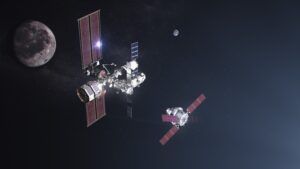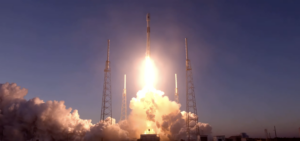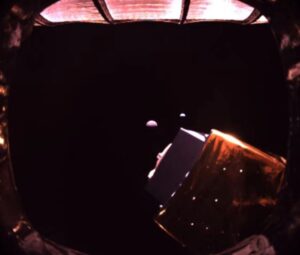Op-ed | Despite tech reset, the space economy is here to stay
Wednesday, 18 January 2023 12:46
The global space industry is expected to eclipse $1 trillion over the next few decades. And while casual onlookers sometimes express skepticism of this rapid growth, the venture industry is clearly enticed by how space technologies can power the global economy.
Reports calls on NASA to improve coordination of Artemis international partnerships
Wednesday, 18 January 2023 11:48
NASA’s inspector general says that the agency needs to do a better job coordinating international partnerships in its Artemis lunar exploration campaign and overcoming obstacles like export control.
The post Reports calls on NASA to improve coordination of Artemis international partnerships appeared first on SpaceNews.
Report calls on NASA to improve coordination of Artemis international partnerships
Wednesday, 18 January 2023 11:48
NASA’s inspector general says that the agency needs to do a better job coordinating international partnerships in its Artemis lunar exploration campaign and overcoming obstacles like export control.
The post Report calls on NASA to improve coordination of Artemis international partnerships appeared first on SpaceNews.
SpaceX launches GPS satellite, Falcon 9’s fifth national security launch
Wednesday, 18 January 2023 11:39
A SpaceX Falcon 9 rocket on Jan. 18 lifted off at 7:24 a.m. Eastern from Space Launch Complex 40 at Cape Canaveral Space Force Station, Florida, carrying a U.S. Space Force GPS satellite.
SpaceX Falcon 9 launches fifth GPS satellite for U.S. Space Force
Wednesday, 18 January 2023 11:39
A SpaceX Falcon 9 rocket on Jan. 18 lifted off at 7:24 a.m. Eastern from Space Launch Complex 40 at Cape Canaveral Space Force Station, Florida, carrying a U.S. Space Force GPS satellite.
Sidus Space expands commercial data distribution through SkyWatch deal
Wednesday, 18 January 2023 10:10 Sidus Space, Inc. (NASDAQ:SIDU)has signed an agreement with SkyWatch for use of its TerraStream data-management platform. The agreement is expected to accelerate the expansion of Sidus' commercial data distribution strategy which includes white labeling data for the Company's existing customers as well as driving growth of new data customers.
Serving as a key contributor to the Space data
Sidus Space, Inc. (NASDAQ:SIDU)has signed an agreement with SkyWatch for use of its TerraStream data-management platform. The agreement is expected to accelerate the expansion of Sidus' commercial data distribution strategy which includes white labeling data for the Company's existing customers as well as driving growth of new data customers.
Serving as a key contributor to the Space data China releases report on remote sensing monitoring for global ecology
Wednesday, 18 January 2023 10:10 China's Ministry of Science and Technology issued a 2022 annual report on the remote sensing monitoring of the global ecological environment on Tuesday in Beijing. The report contains two topics of "ice, snow, and vegetation change in the Arctic region" and "the production situation of global bulk grain and oil crops and the contribution of multiple cropping and irrigation."
The report aim
China's Ministry of Science and Technology issued a 2022 annual report on the remote sensing monitoring of the global ecological environment on Tuesday in Beijing. The report contains two topics of "ice, snow, and vegetation change in the Arctic region" and "the production situation of global bulk grain and oil crops and the contribution of multiple cropping and irrigation."
The report aim Intelligent Computing: The state of the art
Wednesday, 18 January 2023 10:10 Human society on the verge of transforming from an information society to an intelligent society, where optimized computing can autonomously solve practical, real-world problems. Critically, this transition is dependent on the continued development of advanced computing theories and algorithms that impart varying degrees of intelligence to computing systems through autonomous perception, informa
Human society on the verge of transforming from an information society to an intelligent society, where optimized computing can autonomously solve practical, real-world problems. Critically, this transition is dependent on the continued development of advanced computing theories and algorithms that impart varying degrees of intelligence to computing systems through autonomous perception, informa OpenAI, creator of ChatGPT, casts spell on Microsoft
Wednesday, 18 January 2023 10:10 The hottest startup in Silicon Valley right now is OpenAI, the Microsoft-backed developer of ChatGPT, a much-hyped chatbot that can write a poem, college essay or even a line of software code.
Tesla tycoon Elon Musk was an early investor in OpenAI and Microsoft is reported to be in talks to up an initial investment of $1 billion to $10 billion in a goal to challenge Google's world-dominating
The hottest startup in Silicon Valley right now is OpenAI, the Microsoft-backed developer of ChatGPT, a much-hyped chatbot that can write a poem, college essay or even a line of software code.
Tesla tycoon Elon Musk was an early investor in OpenAI and Microsoft is reported to be in talks to up an initial investment of $1 billion to $10 billion in a goal to challenge Google's world-dominating Scientists use laser to guide lightning bolt for first time
Wednesday, 18 January 2023 10:10 Scientists said Monday they have used a laser beam to guide lightning for the first time, hoping the technique will help protect against deadly bolts - and one day maybe even trigger them.
Lightning strikes between 40-120 times a second worldwide, killing more than 4,000 people and causing billions of dollars worth of damage every year.
Yet the main protection against these bolts from a
Scientists said Monday they have used a laser beam to guide lightning for the first time, hoping the technique will help protect against deadly bolts - and one day maybe even trigger them.
Lightning strikes between 40-120 times a second worldwide, killing more than 4,000 people and causing billions of dollars worth of damage every year.
Yet the main protection against these bolts from a China to launch relay satellite next year to support moon landing missions
Wednesday, 18 January 2023 10:06
China will launch its Queqiao-2 communications relay satellite in 2024 to support upcoming robotic landing missions at the lunar south pole and far side of the moon.
New explanation for Jupiter's two massive asteroid swarms
Wednesday, 18 January 2023 07:38 An international team of scientists including NYUAD researcher Nikolaos Georgakarakos and others from the US, Japan, and China led by Jian Li from Nanjing University, has developed new insights that may explain the numerical asymmetry of the L4 and L5 Jupiter Trojan swarms, two clusters containing more than 10,000 asteroids that move along Jupiter's orbital path around the sun.
For decades
An international team of scientists including NYUAD researcher Nikolaos Georgakarakos and others from the US, Japan, and China led by Jian Li from Nanjing University, has developed new insights that may explain the numerical asymmetry of the L4 and L5 Jupiter Trojan swarms, two clusters containing more than 10,000 asteroids that move along Jupiter's orbital path around the sun.
For decades RIT scientists help rediscover earliest known star map using multispectral imaging
Wednesday, 18 January 2023 07:38 Scientists uncovered what they believe to be the first astronomical map. The discovery, outlined in recent studies published in the Journal for the History of Astronomy and the Classical Quarterly, was made in part thanks to multispectral imaging conducted by researchers at Rochester Institute of Technology's Chester F. Carlson Center for Imaging Science.
More than 2,100 years ago, the Gre
Scientists uncovered what they believe to be the first astronomical map. The discovery, outlined in recent studies published in the Journal for the History of Astronomy and the Classical Quarterly, was made in part thanks to multispectral imaging conducted by researchers at Rochester Institute of Technology's Chester F. Carlson Center for Imaging Science.
More than 2,100 years ago, the Gre The moon is a sight for scientific eyes at Raytheon Intelligence and Space
Wednesday, 18 January 2023 07:38 New 3D images of the moon - from Tycho Crater to Hadley Rille - reveal never-seen-before details of the lunar surface. The remarkable new images of the moon's surface provide not only new details about the closest object to our Earth but new scientific opportunities as well.
Raytheon Intelligence and Space has partnered with the National Radio Astronomy Observatory and the Green Bank Obser
New 3D images of the moon - from Tycho Crater to Hadley Rille - reveal never-seen-before details of the lunar surface. The remarkable new images of the moon's surface provide not only new details about the closest object to our Earth but new scientific opportunities as well.
Raytheon Intelligence and Space has partnered with the National Radio Astronomy Observatory and the Green Bank Obser Back on the Job: Sol 3715
Wednesday, 18 January 2023 07:38 Curiosity's science and engineering team members were back at it today after a holiday long weekend, while Curiosity itself was ready and waiting after its own soliday weekend. With the data from the holiday-soliday plan in hand, Curiosity's team was faced with the decision whether or not to drill our current location, and, if so, where.
The Marker Band has proven elusive to drill. Curiosi
Curiosity's science and engineering team members were back at it today after a holiday long weekend, while Curiosity itself was ready and waiting after its own soliday weekend. With the data from the holiday-soliday plan in hand, Curiosity's team was faced with the decision whether or not to drill our current location, and, if so, where.
The Marker Band has proven elusive to drill. Curiosi 
